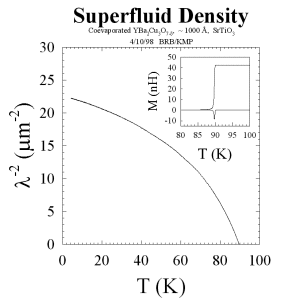Research
Film Growth
We grow superconducting thin films by a technique called Pulsed Laser Deposition (PLD). The technique unfolds in the following steps: a substrate of SrTiO3 or MgO is placed inside a deposition chamber, an excimer laser(KrF, 248nm) is directed by lenses into the deposition chamber, inside the chamber the laser strikes a target composed of a material determined to make up the film, the strike generates plasma that is deposited onto the preheated substrate thus growing a film. See picture of PLD setup.
Our current focus is to grow calcium doped YBCO on SrTiO3 substrates. After the deposition, the cuprate films are annealed in oxygen under different pressures.
Aside from our own research, we also grow semiconductor glass films (GeSe) and perovskite films for other groups.
Measurements

Our featured measurement is a high precision, accurate measurement of the magnetic penetration depth for superconducting films. Shown to the right are typical data on a YBCO film made by codeposition. The noise is about 0.1% and accuracy is about 10 %, the largest source of error being determination of the film thickness. See some recent
results of students in the group.
We measure films ranging from a few unit cells to thousands of Angstroms thick with lateral dimensions of 5 mm square to 20 mm diameter circular. Measurements are possible on smaller or larger samples, but with less accuracy or longer turn around. Please contact Dr. Lemberger if you are interested in making measurements of the penetration depth for your thin film samples. Turn around is often less than a week. "Rush orders" accepted!
We can also make standard measurements like resistivity and magnetic measurements (SQUID). Films sometimes are patterned by photolithography and evaporated with silver/gold to make a better electrical contact. We accept requests to make other resistivity measurements.
